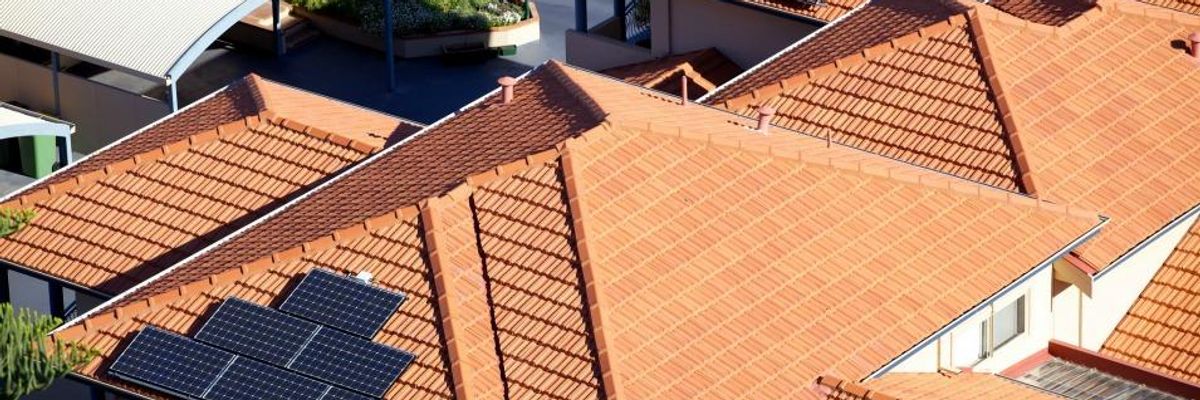

SUBSCRIBE TO OUR FREE NEWSLETTER
Daily news & progressive opinion—funded by the people, not the corporations—delivered straight to your inbox.
5
#000000
#FFFFFF
To donate by check, phone, or other method, see our More Ways to Give page.


Daily news & progressive opinion—funded by the people, not the corporations—delivered straight to your inbox.

Rooftop solar panels. (Photo: Duncan Rawlinson/cc/flickr)
The future of solar energy, often envisioned as an island of reflective panels amid an ecologically sensitive desert outpost, may have a more simple, and more local solution.
A Stanford University study published earlier this week found that utility-scale solar development built alongside existing infrastructure, on rooftops or in backyards, may be more than enough to power whole communities.
The research, published in Nature Climate Change, modeled land-use efficiency in California, a global solar energy hotspot. The study examined how urban areas could be made more efficient by developing more localized sources for renewable energy.
"The quantity of accessible energy potentially produced from photovoltaic (PV) and concentrating solar power (CSP) within the built environment exceeds current statewide demand," the study found.
Common criticisms of large solar arrays are that they can pose a threat to wildlife and crowd out other land uses.
"Our results show that we do not need to trade these places of environmental value for the production of renewable energy as ample land and space exists elsewhere," said Rebecca Hernandez, study lead author and an environmental earth system scientist at Stanford. "Additionally, developing renewable power generation in places close to where it is consumed reduces costs and loss of electricity associated with transmission."
Further, Hernandez notes, rooftops, vacant lots and industrial sites within urban areas are ideal for solar development, as they pose the "least environmental conflict."
The abstract points out that such development "may be an overlooked opportunity for meeting sustainable energy needs in places with land and environmental constraints."
Trump and Musk are on an unconstitutional rampage, aiming for virtually every corner of the federal government. These two right-wing billionaires are targeting nurses, scientists, teachers, daycare providers, judges, veterans, air traffic controllers, and nuclear safety inspectors. No one is safe. The food stamps program, Social Security, Medicare, and Medicaid are next. It’s an unprecedented disaster and a five-alarm fire, but there will be a reckoning. The people did not vote for this. The American people do not want this dystopian hellscape that hides behind claims of “efficiency.” Still, in reality, it is all a giveaway to corporate interests and the libertarian dreams of far-right oligarchs like Musk. Common Dreams is playing a vital role by reporting day and night on this orgy of corruption and greed, as well as what everyday people can do to organize and fight back. As a people-powered nonprofit news outlet, we cover issues the corporate media never will, but we can only continue with our readers’ support. |
The future of solar energy, often envisioned as an island of reflective panels amid an ecologically sensitive desert outpost, may have a more simple, and more local solution.
A Stanford University study published earlier this week found that utility-scale solar development built alongside existing infrastructure, on rooftops or in backyards, may be more than enough to power whole communities.
The research, published in Nature Climate Change, modeled land-use efficiency in California, a global solar energy hotspot. The study examined how urban areas could be made more efficient by developing more localized sources for renewable energy.
"The quantity of accessible energy potentially produced from photovoltaic (PV) and concentrating solar power (CSP) within the built environment exceeds current statewide demand," the study found.
Common criticisms of large solar arrays are that they can pose a threat to wildlife and crowd out other land uses.
"Our results show that we do not need to trade these places of environmental value for the production of renewable energy as ample land and space exists elsewhere," said Rebecca Hernandez, study lead author and an environmental earth system scientist at Stanford. "Additionally, developing renewable power generation in places close to where it is consumed reduces costs and loss of electricity associated with transmission."
Further, Hernandez notes, rooftops, vacant lots and industrial sites within urban areas are ideal for solar development, as they pose the "least environmental conflict."
The abstract points out that such development "may be an overlooked opportunity for meeting sustainable energy needs in places with land and environmental constraints."
The future of solar energy, often envisioned as an island of reflective panels amid an ecologically sensitive desert outpost, may have a more simple, and more local solution.
A Stanford University study published earlier this week found that utility-scale solar development built alongside existing infrastructure, on rooftops or in backyards, may be more than enough to power whole communities.
The research, published in Nature Climate Change, modeled land-use efficiency in California, a global solar energy hotspot. The study examined how urban areas could be made more efficient by developing more localized sources for renewable energy.
"The quantity of accessible energy potentially produced from photovoltaic (PV) and concentrating solar power (CSP) within the built environment exceeds current statewide demand," the study found.
Common criticisms of large solar arrays are that they can pose a threat to wildlife and crowd out other land uses.
"Our results show that we do not need to trade these places of environmental value for the production of renewable energy as ample land and space exists elsewhere," said Rebecca Hernandez, study lead author and an environmental earth system scientist at Stanford. "Additionally, developing renewable power generation in places close to where it is consumed reduces costs and loss of electricity associated with transmission."
Further, Hernandez notes, rooftops, vacant lots and industrial sites within urban areas are ideal for solar development, as they pose the "least environmental conflict."
The abstract points out that such development "may be an overlooked opportunity for meeting sustainable energy needs in places with land and environmental constraints."